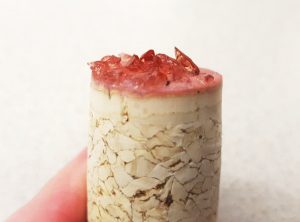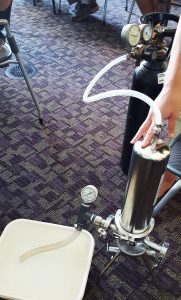While you may be contemplating registering for our “Everything You Wanted to Know About Bottling, But Were Afraid to Ask” webinar series, I wanted to share a few things I’ve observed wineries forgetting prior to putting a wine in bottle. These are four pre-bottling steps can make the difference between bottled wine safely delivered to a consumer, and having to uncork bottled wines that require rework. Let’s break down four things I see many wineries “forget” or “eliminate” as they gear up for bottling that can cause some large headaches in the cellar:
1. Assessing Cold and Protein (Heat) Stabilities

Wineries in colder regions tend to put wines through cold stability a bit out of sequence. Many force wines through cold stability during the coldest months of the year even if the wines aren’t ready for the cold stabilization process or [potentially] don’t need it.
Traditionally, wines are evaluated for protein (heat) stability and then treated with bentonite right before going through cold stabilization. This allows for fewer wine movements to reserve aromatics in more delicate wines. Only one racking is required from both bentonite additions and precipitated tartrates when completed in this order. Scientifically, this order does not make the most sense as protein stability is influenced in pH shifts, and cold stabilization likely causes a pH shift.
Furthermore, it’s easy to forget that blended wines are not necessarily cold or protein stable if they are blended after the blend’s individual parts went through those processes. Any changes to the acid structure requires a reassessment of cold and protein stability.
What’s the bottom line? Make sure you analytically double check these two physical chemistries, tartrate and protein stability, before putting the wine into bottle. DG Winemaking clients can use the Pre-Bottling Prep Production Guides as step-by-step timelines that ensure the wines go through a good sequence.
2. Checking Dissolved Oxygen (DO) and Carbon Dioxide (CO2) Levels
After primary fermentation, wines are saturated with dissolved carbon dioxide (CO2). However, as wines are moved through various production steps, the carbon dioxide evaporates from the wine and the wine will begin to pick up oxygen. Oxygen is also absorbed through the wine through wine-to-oxygen interfaces, which is why managing headspace in tanks and barrels is so important.
University research groups (Ohio State) and industry suppliers (Nomacork) have shown a huge amount of variation in dissolved oxygen content as wines go into bottle. Smaller wineries (under 10,000 case annual production) are most susceptible to larger DO pick up compared to larger winemaking facilities.
DO variability is difficult to manage and understand. However, DO levels in the wine prior to bottling, plus the amount of oxygen incorporated into the bottle during bottling operations, can influence post-bottling wine quality. These oxygen levels degrade free sulfur dioxide content in the wine post-bottling. Decreasing sulfur dioxide levels enhances susceptibility of post-bottling oxidation as well as spoilage, especially if invalidated cleaning and sanitation practices were employed.
What should a winery do about DO? Consider measuring DO as a pre-bottling quality check for your wine. In contrast, if you know the wine is not getting transferred often or was bottled young, it’s possible that the wine could retain too much dissolved CO2. Checking for dissolved CO2 levels using a carbodoseur is quick and easy for many small wineries to do. You can see a ~3-minute video on how this is done, here.
If you need more information on DO in wine or recommendations for a DO meter, there is a free webinar on the DG Winemaking website which was previously presented by Scott Labs’ Field Sales Rep, Luke Holcombe, here.
3. Using a Bubble Point Test to Evaluate Sterile Filtration Efficacy
Even though wines are put through a sterile filtration process, the wines are not bottled sterile. I know that sounds confusing, but it’s important to remember that wineries do not commonly package wines under sterile bottling conditions. After the wine leaves a filter, it will flow through a series of hoses, pumps, a possible holding tank, the bottling line, the filling spouts, and the wine bottle itself. Most of those downstream pieces of equipment are not sterile and hence offer opportunities for microbial contamination during the bottling process.
However, sterile filtration offers a final opportunity to remove as much unwanted yeast and bacteria from the wine as possible. The reduction of microflora in the wine provides a fighting chance for sulfur dioxide to work its magic most effectively assuming it is in correct proportions based on the wine’s pH.
If this step is so important (and expensive), why not ensure your sterile filtration process is actually working properly?
A bubble point test is an easy way to ensure the sterile filter’s efficacy (i.e., the filtration cartridge is effectively removing unwanted microorganisms). Scott Labs offers a great, 8-minute video on how to set up a sterile filter and run a bubble point test, which you can watch, here. They also provide a nice protocol for running a bubble point integrity test, here. If needed, I can provide additional protocols for DG Winemaking clients.
When should you run a bubble point test? I recommend wineries test the filter integrity immediately before the start of bottling, right before and right after they return from any bottling breaks, and at the end of the bottling day. This gives you four check points that provide filter integrity data.
Why should you have multiple check points? Let’s say you only run a bubble point test before bottling operations starts and after bottling operations is completed. If the end-of-day bubble point test shows that filter integrity has been lost, you have no time indication when the filter went down. However, assuming the team takes a mid-day lunch break, running a bubbling point test before the break confirms filter integrity has been sustained during that morning bottling run. If the bubble point test is confirmed after lunch, but fails at the end of the day, now you know only half of your bottling day has been compromised, as opposed to the entire day’s work.
4. Having Good Bottling Sanitation Standard Operating Procedures
Whether you have a manual bottling and capping system, or a high-tech bottling line, physically cleaning and properly sanitizing the bottling line is essential to maintaining proper hygiene in the winery. Remember, cleaning is the “physical removal of visible material or debris from equipment surfaces” while sanitizing is the “reduction of microorganisms through chemical or heat addition” (Fugelsang and Edwards, 2007).
As bottling is one of the key areas where the quality of the product can greatly be degraded, having good sanitation standard operating procedures (SSOPs) in place for bottling operations is essential. If you need assistance in writing a good SSOP, DG Winemaking offers an online training module available that provides step-by-step instructions for writing good SOPs/SSOPs. This training instructs you to include both pre- and post-operations protocols for how to properly clean and sanitize a bottling line.
Some quick tips on cleaning:
- Have dedicated brushes specifically used for cleaning the bottling line.
- Utilize detergents that break down wine debris or environmental dust.
- Remove valves, hose lines, etc. to physically clean off debris or biofilms (caked on material that can host microorganisms).
- Don’t forget “hard to reach places” like filler bowls and filler spouts.
Sanitation follows cleaning, and it’s essential that your cleaning practices remove all physical dirt and debris from the bottling line. Otherwise, the sanitation step is literally “cleaning dirt” and the point of sanitation is not being fulfilled.
The efficacy of cleaning and sanitizing is dependent on the processor to complete this task correctly. Both cleaning and sanitation should take place immediately before bottling and immediately after bottling is completed. If you struggle to understand sanitation concepts, the Darn Good Winemakers network has previously covered this topic in the webinar titled, “Sanitation Steps that Work!“
And these are things that can go wrong before bottling wine. Don’t forget to check out our upcoming webinar that covers everything and anything about bottling wine correctly:
References
Fugelsang, K. and C. Edwards. 2007. Wine Microbiology. ISBN: 978-0-387-33349-6

